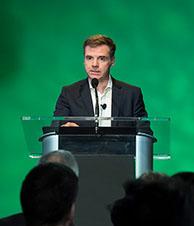Q&A: Gift Planning to Help the MIT Mission
Israel Ruiz SM ’01

Israel Ruiz, executive vice president and treasurer, is MIT’s chief financial officer, and he is responsible for leading all of the administrative and financial functions at the Institute. Ruiz talked with the MIT Office of Gift Planning to answer a few questions about how a planned gift helps support MIT’s education and research mission.
How does planned giving help support MIT’s mission to advance knowledge and educate students?
IR: Planned giving is an essential source of funding that ensures the future sustainability of MIT. In particular, unrestricted planned gifts allow MIT to strategically focus on its core activities, including scholarship support and campus renewal. In fiscal year 2017, 18.2% of MIT’s philanthropic support came from planned giving.
Why should someone consider supporting MIT with a planned gift?
IR: A planned gift offers the opportunity for donors to maximize the impact of their giving with options that fit their current stage in life. In addition to supporting MIT, planned gifts offer benefits to the donor, including being able to plan now for a future legacy on campus. Another advantage to this type of gift is that a life income gift—a charitable gift annuity or charitable remainder trust—can provide income to the donor and/or their beneficiaries. A planned gift is a terrific vehicle for just about anyone who wishes to support the mission of MIT.
What makes MIT stand out as a philanthropic choice for a life income gift?
IR: A life income gift offers a unique opportunity to invest alongside the MIT endowment. Last fiscal year, the Institute’s pooled investments returned 14.3%, growing the endowment to $14.8 billion (excluding pledges), and charitable remainder unitrusts benefited from this strong investment performance. Gift annuities are invested alongside MIT’s endowment and the Institute’s long-term investment pool, and they can provide a stable income source. MIT stands to gain in the future due to our prudent investment strategies for the endowment. At the end of fiscal year 2016–2017, MIT’s 10-year endowment return stood at 7.6%, outperforming the 30 largest college and university endowment pools.
What impact will the MIT Campaign for a Better World have on the Institute?
IR: The Institute’s future depends upon the current philanthropic support of our alumni and friends. The MIT Campaign for a Better World has already raised $4 billion towards our ambitious $5 billion goal. MIT’s strong financial foundation has made it possible to realize significant achievements that will extend the Institute’s global impact and pave the way for groundbreaking discovery and innovation in areas ranging from basic scientific research to human health. Because of the generosity of our donors, we are able to further progress in education, including financial aid and digital learning. The Campaign is also aimed at meeting the core needs of our community, including a number of significant capital renewal and construction projects that are essential to enabling the Institute’s education and research mission, such as MIT.nano, a new undergraduate residence hall in West Campus, and major developments in Kendall Square. This is the Campaign that will propel the Institute to continue its service to the world, and every gift in support of this effort will make a difference.
